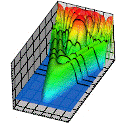Department of Physics and Astronomy: Publications and Other Research

Anthony F. Starace Publications
Document Type
Article
Date of this Version
2011
Abstract
The problem of the shift and broadening of the electron energy levels in the field of two 3D short-range potentials (e.g., the model of a negative molecular ion) by a constant electric field F is considered. The interaction of an electron with attraction centers is taken into account in the effective range approximation. We analyze the cases when both centers maintain weakly bound s states and when the electron state in the field of one of the centers is a p state. Exact numerical results for the shift and the width of the energy levels of a quasi-molecule as functions of field F, distance R between atomic centers, and the orientation of the quasi-molecule axis relative to vector F are presented, as well as the results of analytic treatment for a number of limiting cases. The exact values of complex energies of the quasi-molecule are compared with analytic results for a weak field in the case of identical s centers [26], as well as nonequivalent s centers and s–p centers; the applicability boundaries of the weak field approximation are established. It is shown that for large values of R, the position and width of the levels in a strong field are correctly described in perturbation theory in the exchange interaction. We analyze the field-induced quasi-intersection of molecular energy levels of the system with nonequivalent atomic centers and peculiarities in the energy level widths associated with this intersection. The results make it possible to qualitatively interpret the results of numerical calculations of the probability of homo- and heteronuclear molecules being ionized by a low-frequency laser field.


Comments
Published in Journal of Experimental and Theoretical Physics, 2011, Vol. 112, No. 5, pp. 725–743. © Pleiades Publishing, Inc., 2011. Original Russian Text © S.V. Borzunov, N.L. Manakov, A.F. Starace, M.V. Frolov, 2011, published in Zhurnal Eksperimental’noi i Teoreticheskoi Fiziki, 2011, Vol. 139, No. 5, pp. 835–855.
DOI: 10.1134/S1063776111030095